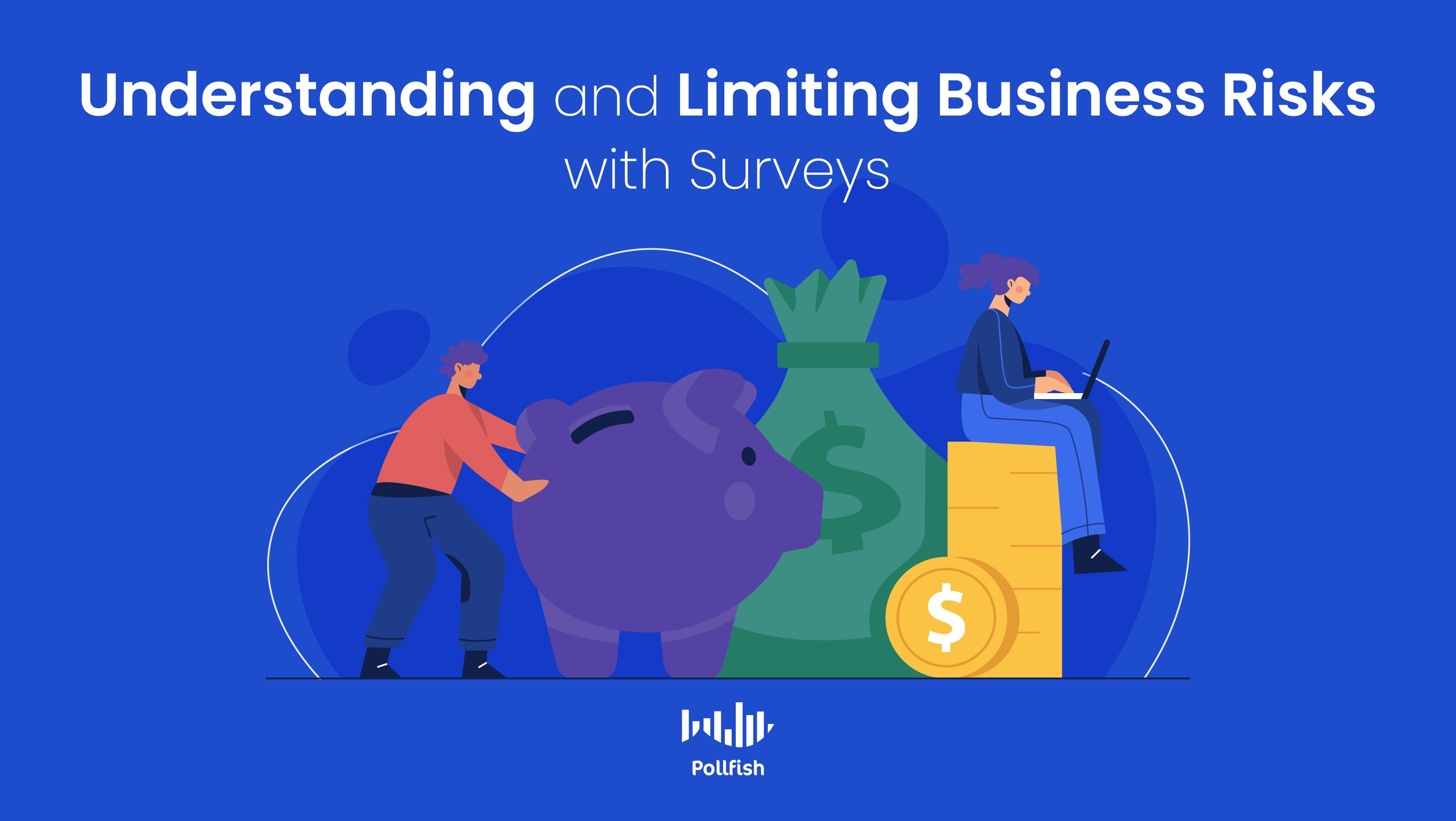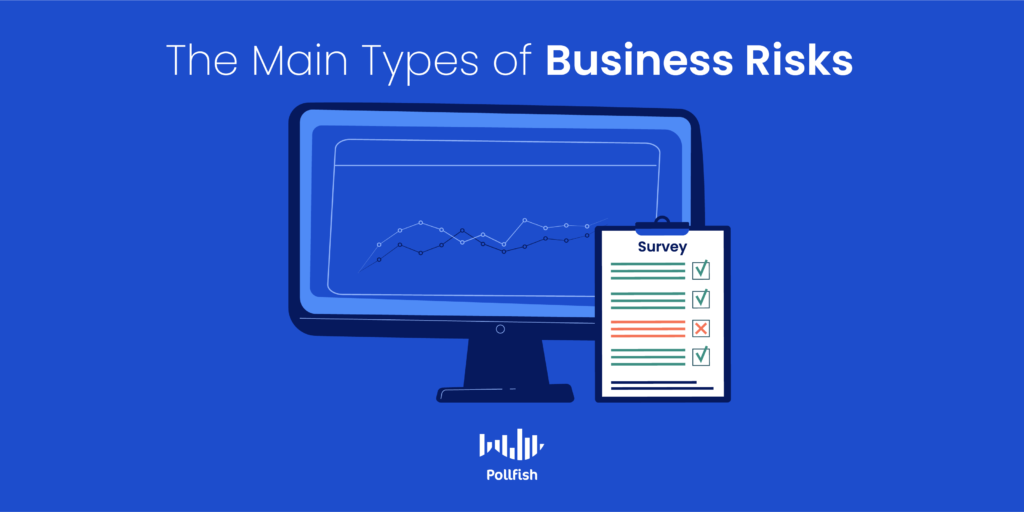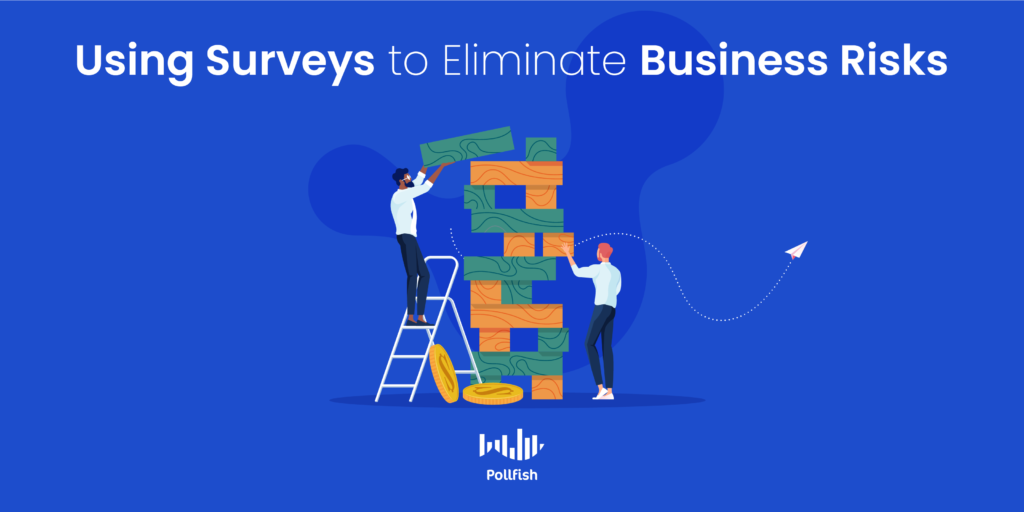How to Uncover and Minimize Business Risks with Surveys

Businesses must work towards uncovering and preventing business risks, as running a business is often a risky operation — especially for fledgling companies. For a fourth of new businesses, failure is imminent, as 20% of businesses fail within the first year.
The leading worldwide business risk is business interruption at 41%, which includes supply chain disruption. The next most common risks for businesses are pandemic outbreaks – 40%,
Cyber incidents – 40% and market developments – 19%.
While it is impossible to be immune to all business risks, a well-prepared business can lessen and even avoid risks in some cases, with the use of data-driven decision making. They can also do this by honing in on their business strategy.
This article explores business risks and how surveys can be used to discover and minimize them early on.
Understanding Business Risks
Business risks refer to any threat a company may experience in its ability to achieve its financial goals. A risk can also mean that a business’s plans may not turn out as they were originally planned or that they do not meet their targets, objectives, or KPIs.
A risk can also include the chance of exposure to any factors that lower a business’s profit and chances of success. These factors can vary, ranging from internal business risk factors, such as technological, human, physical, structural, political, mismanagement, etc.
There are various risks that cannot be blamed on a business itself, which include external factors, such as increased prices of raw materials, a new pool of competitors, and government regulations.
Virtually anything that threatens a company from achieving its financial goals can be considered a business risk. As such, businesses need to be aware of all their possible risks, how to counteract them, and mainly, how to prevent them from causing any impact.
There are also external risk factors that a business can rein in or reduce, such as those present in target market demands, customer behavior, and tastes. To do so, businesses must take part in a strategic planning process and create business safety nets.
The Main Types of Business Risks

While there are various kinds of business risks, businesses can better identify them and remember them by understanding their broader categories. The two main types of business risks are internal and external. In this binary, each category has the power to affect the other.
The following lists the main types of risks businesses can experience, along with their various major subcategories
Internal Business Risks
Internal risks occur from within a company and can result in various setbacks every now and then. These risks can be predicted reliably, as they emerge from a business itself. Businesses have a good chance of reducing these kinds of risks.
Here are several major internal risks that a business can face:
- Human risks:
- Union strikes
- Employee performance, including idle workers
- Ineffective management and/ or leadership
- Poor relationships with external producers or suppliers
- Clients and customers who fail to pay on time
- Physical risks:
- Loss of or damage of company assets
- Loss or damage of office equipment and buildings
- In-office physical risks such as issues (even minor) in building/ wall structure
- Crimes such as theft and vandalism
- Technological risks:
- Product and service changes in the manufacturing, delivery, or distribution
- Outdated operating systems that decrease production or cause disruptions in supplies or inventory.
- A lack of IT staff investing that supports company systems
- Server and software issues leading to equipment downtime
- Production deficits
External Business Risks
These risks often include economic events outside of the business’s structure. External factors can be unexpected and take a turn for the worse, as they involve virtually any undesirable outside force or phenomenon. It can be more difficult to reduce these risks given that they cannot be forecasted effectively.
Identifying Business Risks
Risks are identified in a number of ways. Strategies to identify these risks rely on comprehensively analyzing a company’s specific business activities. Most organizations face preventable, strategic, and external threats that can be managed through acceptance, transfer, reduction, or elimination.
The following are several major external risks that a business can face:
- Natural risks:
- Natural disasters that affect business operations such as remaining open.
- Damages to office buildings and merchandise
- Being forced to shut down temporarily or reduce hours of operation
- Political and legislative risks:
- Changes in the political, environmental, or governmental policy
- Changes in import and export laws, taxes, tariffs
- Legal risks
- Regulations that may seem unwarranted or affect a business negatively
- Compliance policies such as data protection and payment processing
- Economic risks:
- Changes in market conditions
- Economic downturns such as recessions
- Increased levels of unemployment
- Entry of new competitors
- Revenue loss
- Changes to customer buying behavior
- Security and fraud risks
- Hacking opportunities across channels
- Data breaches
- Payment fraud
- Reputation risks
- Dissatisfied customers
- Product failures or dissatisfaction with products
- Lawsuits
- Negative press
- Damage to brand equity
How Surveys Uncover and Reduce Business Risks

There are many ways to identify the two major risks within an organization. Given the varying nature of business risks, businesses must implement several strategies to uncover and reduce them, if not completely eradicate them.
These methods include conducting secondary market research to identify industry-specific risks, analyzing customer complaints via a VoC (voice of the customer program), conducting internal and external research, analyzing any suspected risk sources and other means.
Fortunately, surveys provide a direct approach to tackling many of these ways to uncover and reduce risks. This is because surveys can be used to study virtually any topic or concern of interest.
Surveys complement secondary market research, as they provide business-specific information, granting market researchers the opportunity to ask their own questions and to use a precise survey sample based on the required target population.
Surveys allow researchers to gain firsthand insight into their customers. They can dig further into customer complaints, by assessing the number of people within a target market that share the same concerns and may have the same complaints. In this way, they provide qualitative market research in addition to quantitative market research.
While there are many unforeseen changes that can occur, businesses can make them more predictable and therefore, manageable by conducting surveys. This is because businesses can use these tools to gain insight into various markets, including global ones via global market research.
They can assess whether external factors have any bearing on their customers and how to best respond to them. In this way, businesses can both uncover and minimize their risks with surveys. As such, surveys can also be used to compare a business with its competitors, helping to assure that the business doesn’t fall behind and risk losing market share.
Implementing surveys is also valuable for branding, as they can be used for brand tracking, helping businesses keep track of their reputation, and warding off reputational risks.
In this way, market researchers can set up such survey campaigns to gain access into the public opinions of their business. They can research how their current branding, advertising, and PR campaigns are faring with their target market. They can also do this with A/B testing.
All in all, although business risks vary in nature and impact on a business, surveys help counter the risks by identifying them and preparing researchers to mitigate them.
Preventing all Undesirable Business Happenings
Businesses must equip themselves with all the necessary tools and strategies to help them identify and reduce business risks. As such, there is no single solution to these risks.
However, surveys provide an excellent source of customer and even competitor information that can inform businesses on their risk factors and overall environment. In order to reap the most benefits out of surveys and effectively reduce risks, businesses must choose the proper online survey platform. Such a platform should make it easy to create and deploy surveys and have the capability to distribute surveys to a massive network while ensuring they are answered by the targeted population.
In addition, a strong survey platform should extract quality data, which is made possible through the RDE (random device engagement) sampling method, which engages respondents in their natural digital habitats in a completely randomized way. It should also rely on artificial intelligence to perform quality checks that ensure the highest quality of customer data.
When a company uses an online survey platform of this caliber, it is setting itself up for success and mitigating its risks.
admin
Ready to Try Pollfish?
Create your survey with AI, target high-quality respondents starting at $0.95 per complete, and start getting results in just minutes in real-time. From running a simple product concept survey to managing a constant stream of trackers for dozens of clients in dozens of countries, we’ve got you.
